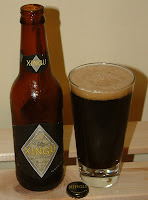
I do love the Google Maps street view thingy. For this month's Session we've been
asked to talk about a beer from the furthest brewery we've ever been to -- a topic hand-picked for a checklist beer tourist like me -- and Google Maps lets me wander up and down Rattray Street in Dunedin, home of the Speight's Brewery which I visited back in 2006 and is the most distant one I've been to.
Look: you can even see the free water fountain to the left of the front door which the brewery provides for the townsfolk.
It's just a shame that the beers made by Speight's (a division of all-conquering antipodean drinks giant Lion Nathan) are mostly not very good. I
really enjoyed a couple of them though -- the Old Dark and Chocolate Ale -- but all you ever see here is the flagship Gold Medal Ale.

New Zealand must be one of very few countries in the world -- alongside Ireland and the UK -- where the default beer style isn't lager. Instead it's a bland, light red ale generally called "Draught". Like Irish reds, I assume that there is a full flavoured English pale ale somewhere in its ancestry, but big brewing interests have shaped the national taste to their own nefarious ends, and New Zealand Draught is the cold, dull result.
It took a fair bit of effort to track down a bottle in Dublin, but the redoubtable
Deveney's in Dundrum was able to meet my needs. Mind you, since this is brewed in factories in Christchurch and Auckland as well as the headquarters down in Dunedin, I can be fairly sure that the particular bottle I had did not actually come from the brewery I visited. I hope that doesn't put me outside the Session rules.
My abiding memory of the beer, as recorded after
first meeting it, was that it tasted like Carlsberg. Now, nearly three years later, I think it's actually worse. It's very watery and slightly musty, despite being several weeks inside its best-before. There's a trace of a caramel malt sweetness somewhere at the back, but it's gone in an instant. It may be an ale on a technicality, but this is far closer to generic world lager than the ale it probably once was.

For me, however, the pleasure of travel is far more in the anticipation than the memories. I've drank beer on all but one of Earth's inhabited continents; only South America has eluded me so far. To get a little bit of a vicarious thrill from a far-away brewery, I picked up two beers from a Brazil's Cervejarias Kaiser. First up is
Palma Louca, their pale lager. Not much by way of a head on this one and the fizz is fine and balanced. I thought I detected a whiff of vinegar from it on pouring, but I may have imagined it as it is fairly odourless and as light in the taste department as it is in colour (very). But I have to say I quite liked it. It could easily have been an overly fizzy, sugar-laden monstrosity, or a watery concoction that barely resembles beer, but despite some scary E-numbered adjuncts, this is an easily quaffable no nonsense hot-country lager. If it's left to get warm, a hint of green apples appears, but letting it get warm is
really not what this beer is about. It was slightly out of date so I paid €1 for it in
DrinkStore and, drinking it on a stiflingly hot evening earlier this week, I couldn't help but feel I got my money's worth.
 Xingu
Xingu is the name of the brewery's black lager, also €1, but I don't think I did as well here. It looks attractive enough, with its tan head and dense brown body, and I think there's a pleasant, mild-like light coffee roastedness hidden in there somewhere. But for the most part it's as tasteless as the lager, and the little bit of flavour that does come through has a rather unpleasant brown sugar stickiness to it. Again it's far too bland to be actually considered bad, but it leaves you searching for the taste, and when you find it you feel you wasted the effort.
Like most of the world, I expect South America to be a mixed bag, beerwise. And isn't that half the joy of intercontinental beer travel? I wouldn't have it any other way.
 It's one of those legends of the beer world that, up until recently, had never crossed my path. I had absolutely no idea what to expect from Liefmans Goudenband: lots and lots of people have told me it was brilliant, but no-one ever said why.
It's one of those legends of the beer world that, up until recently, had never crossed my path. I had absolutely no idea what to expect from Liefmans Goudenband: lots and lots of people have told me it was brilliant, but no-one ever said why.














